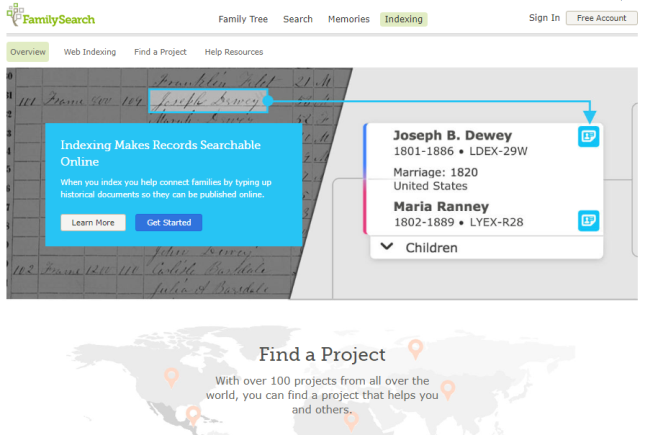New Genealogy Records on the Genealogy Giants
Millions of new genealogy records for Australia, the British Isles, the U.S., Canada, Europe, and Central and South America have been added to Ancestry.com, FamilySearch.org, Findmypast.com and MyHeritage.com, the “genealogy giants.”This week, we’ve sorted them by...Join the Crowd: Help Make History with FamilySearch Indexing Event Oct 20-22
 You’re invited to participate in a global FamilySearch indexing event! Join thousands of volunteers worldwide October 20-22, 2017 as they index historical records that will help genealogists (maybe you) climb your family tree. If you can index in another language, you have a VIP invitation–your skills are especially needed.
You’re invited to participate in a global FamilySearch indexing event! Join thousands of volunteers worldwide October 20-22, 2017 as they index historical records that will help genealogists (maybe you) climb your family tree. If you can index in another language, you have a VIP invitation–your skills are especially needed.
 This coming weekend, FamilySearch is throwing its annual global indexing party: a three-day event designed to get genealogists away from their own database searches for just long enough to contribute to building those databases. It’s the Worldwide FamilySearch Indexing Event, and it runs October 20–22, 2017.
This coming weekend, FamilySearch is throwing its annual global indexing party: a three-day event designed to get genealogists away from their own database searches for just long enough to contribute to building those databases. It’s the Worldwide FamilySearch Indexing Event, and it runs October 20–22, 2017.
What is FamilySearch indexing?
Indexing is the process of extracting ancestral information from the world’s historical documents and putting them into online databases to help researchers find their ancestors in them more easily.
Here’s a quick video that illustrates the process (it’s a super cute video):
Why Is There a FamilySearch Indexing Event?
FamilySearch runs the world’s best-known volunteer online indexing system. This system has helped tens of thousands of volunteers index millions of names that are now searchable for free on FamilySearch.org and other websites. The annual three-day FamilySearch indexing event concentrates the year-round efforts of indexers into an energetic burst of activity. It also shines a light on the important service performed by FamilySearch indexers and attracts new (and lapsed) helpers to the cause.
Last year’s event galvanized over 100,000 volunteers, who indexed more than 10 million historic records in the three-day period. A FamilySearch representative stated, “From its beginning on Thursday in Southeast Asia and Australia to its conclusion Sunday night in the Pacific, the event attracted a wide range of participants. Volunteers contributed online from home or participated in locally organized events from Zurich, Switzerland, to the Rocky Mountains in the United States.”
Indexing volunteers with non-English language skills are particularly needed at this time. Over 200 FamilySearch digital camera teams are currently photographing historic records from non-English speaking countries. The effort has created a huge need and opportunity for indexers to make these records freely searchable online.
Volunteers can choose from projects of interest from all over the world and in several languages: English, Spanish, French, German, Italian, Portuguese, Russian, Japanese, Polish, Swedish, and Dutch.
What’s New at This Year’s FamilySearch Indexing Event?
This year, the FamilySearch indexing portal became entirely cloud-based, a step forward in this increasingly mobile world. Now you can index on-the-go on your tablet or phone as well as at your computer. You can also modify the layout of your dashboard based on personal preferences, set and track individual goals, and even create groups with friends (or others interested in working on a common project, such as your society members).
RSVP for the FamilySearch Indexing Event
This year’s FamilySearch indexing event has a dedicated webpage where you can RSVP and learn more. All you need to begin indexing is a FamilySearch.org account and access to the internet. (And for this event, a little bit of time between October 20-22, 2017.)
Ready to join the fun? Visit FamilySearch.org/indexingevent2017 to get started.
Learn more about FamilySearch Historical Records in the Genealogy Gems Podcast
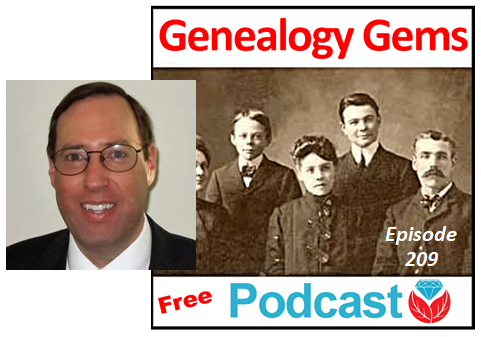 David Ouimette is known to his FamilySearch colleagues as “the Indiana Jones of genealogy” because of his globe-trotting adventures in discovering historical record treasures. Hear from him in the newest free episode of Lisa Louise Cooke’s Genealogy Gems Podcast. Click here to listen!
David Ouimette is known to his FamilySearch colleagues as “the Indiana Jones of genealogy” because of his globe-trotting adventures in discovering historical record treasures. Hear from him in the newest free episode of Lisa Louise Cooke’s Genealogy Gems Podcast. Click here to listen!
How to Find Draft Registration Records and What They May Tell You about Your Ancestors
Do you have ALL your ancestors’ U.S. draft registration records–from the Civil War until after World War II? These documents may be filled with genealogy clues, whether your ancestor served in a war or not. Military expert Michael Strauss presents this roll call of U.S. draft registration records you’ll want to check!
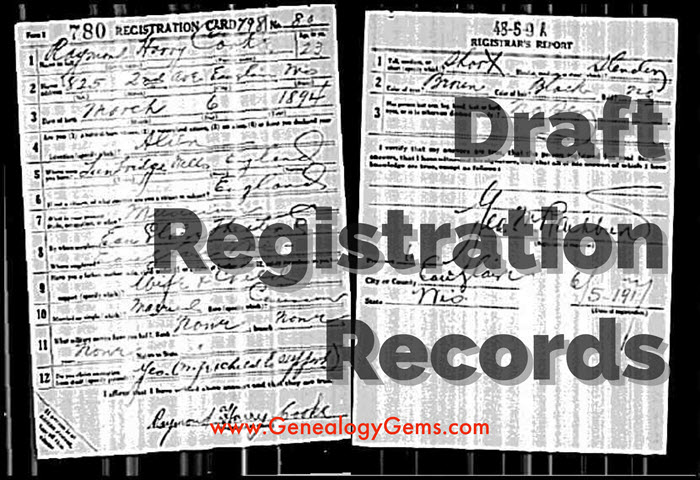
Thanks to Michael L. Strauss of Genealogy Research Network for providing this guest post.
Military records can lead genealogists to many new sources of information. One of the first records that you may come across (for our United States ancestors) that could provide unknown information are found in draft registrations. The records are civilian in scope, but can provide clues of prior military service or proof of current war conditions.
The National Archives holds custody overall for the bulk of the draft registrations from the Civil War to post-war World War II. The Archives organizes their records by grouping numbers. The Civil War draft registrations are found in two record groups, RG59 and RG110. Later draft registrations are found in RG147. In all cases, finding aids are available to locate and obtain copies.
Civil War Draft Registration Records

Recruiting poster, New York printed by Baker & Godwin, June 23, 1863. Public domain image hosted at Wikipedia.org (click to view).
Civil War draft records date back to the first national draft which was signed by Abraham Lincoln on March 3, 1863. This draft only applied to men residing in states under Union control. The draft includes several lists detailing information about men eligible to be drafted to fight for the Federal Army. This included consolidated lists for men between the ages of 20-45, which are grouped and divided into two classes of records. This list contains the name, residence, age, race, marital status, place of birth, any former military service, occupation, and remarks for each registrant. (Remarks might include ineligibility based on religious reasons or former service in the Confederate Army.)
Other registrations included medical exams, statements of substitutes, and case files of persons who were draft aliens. (Aliens were ineligible for military service and therefore contain files that document their nativity.) All of these are at the National Archives.
The last group of records includes the descriptive rolls that contain the name, age, physical descriptions, where born, occupation, when and where drafted, and remarks. The descriptive books are located at the regional branches of the National Archives and can be accessed by researchers, as these have not been filmed or scanned. Records are divided into two separate record groups: RG59 (Department of State) covered those men who were aliens and RG110 (Provost Marshal) has all the other lists of men being drafted.
The only Civil War draft registration records available online are the consolidated lists; click here to search them at Ancestry.com (subscription required). On the Confederate side, there are a limited number of draft records available, some at the National Archive and some in the custody of individual state archives.
World War I Draft Registration Records
For a number of years, there was no draft or draft registration. However, when the United States entered the war in Europe on April 6, 1917, the country was totally unprepared for overseas campaigning. This conflict forced our government to consider other means to recruit the tens of thousands of men it would take to wage this war. The Selective Service Act of 1917 authorized the President of the United States to increase the military establishment being passed by Congress on May 18, 1917. The Act directed the Provost Marshal General Office (P.M.G.O.) to select men eligible for military service.
All men were required to register, native-born or aliens. The draft is separated into three registrations:
- The 1st draft registration was dated June 5, 1917 for men aged 21 to 31 and consisted of 12 questions.
- The 2nd draft registration was dated June 5, 1918 for men who had turned 21 since the previous registration and included a supplemental registration on August 24, 1918 for men turning 21 after June 5, 1918. Each consisted of 10 questions.
- The 3rd draft registration was dated September 12, 1918 and was intended for all men aged 18 to 45 years. It consisted of 20 questions.
Each registrant was required to provide their name, age, birth date, and birthplace (in 2 of the 3 registrations), occupation or employer, nearest family, and a summarized physical description.

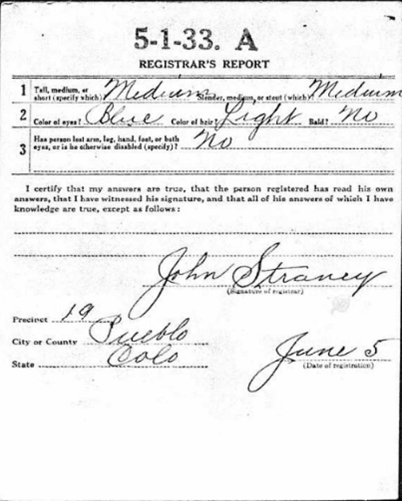
WWI draft registration of Henry Fox. Image from Ancestry.com.
By the end of World War I, nearly 24 million men had registered for the draft (this number excluded registered enemy aliens and those already in the military). The original draft cards are at the National Archives branch in Morrow, Georgia. World War I draft registrations are available online at Ancestry.com, FamilySearch.org, Findmypast.com and fold3. FamilySearch is the only one with free access (a personal subscription or library access is required for the others).
World War II Draft Registration Records
The eve of World War II saw the passage of another conscription act. This act was the Selective Training and Service Act of 1940, and was the first peace time conscription in United States History. This act officially established the Selective Service System. The draft during World War II consisted of seven registrations. The “Old Man’s Draft,” or 4th registration, was for men born between 1877 and 1897, with the other six registrations intended for the younger adult men born after 1897:
- 1st: October 16, 1940, included all men 21-31.
- 2nd: July 1, 1941, for those men who reached age 21 since the first registration.
- 3rd: February 16, 1942, for men ages 20-21 and ages 35-44.
- 4th: April 27, 1942, for all men between the ages of 45 and 64. The registrants were not eligible for military service (this is the “Old Man’s Draft”).
- 5th: June 30, 1942, for all men between the ages of 18 and 20.
- 6th: December 10 – 31, 1942, for all men who had reached the age of 18 since the previous registration.
- 7th: November 16 – December 31, 1943, for American men living abroad between the ages of 18 and 44.
Registrants were required to provide their name, address, birth date, birthplace, and employer’s information, along with a contact individual who would always know the registrant’s information or address. The form also asked for the telephone number of the registrant in addition to a more complete physical description.
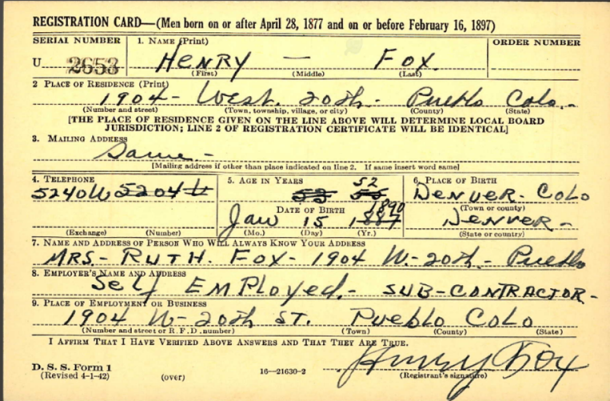
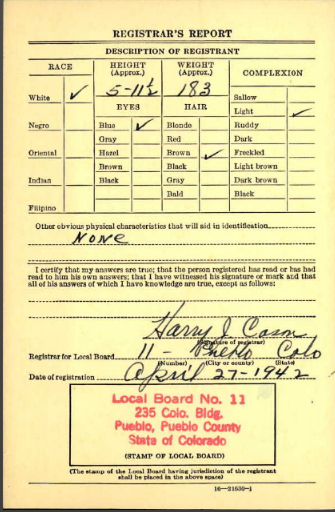
WWII draft registration of Henry Fox. Image from Ancestry.com.
Several of the states that recorded the “Old Man’s Draft” were lost. The National Archives no longer has these records available. These states include: AL, FL, GA, KY, MS, NC, SC, and TN.
Not all of the World War II Draft registrations are available online. Less the states above, view 4th registrations online at Ancestry.com, Familysearch.org (index and browse-only images) and fold3. The fold3 database includes 25 states and territories: AL, AK, AR, AR, CO, CT, DE, FL, GA, HA, ID, LA, MD, NV, NM, NC, OK, PA, UT, VA, WV, WY, and the District of Columbia and the Virgin Islands. (On Ancestry.com, the number of states is limited to AR, GA, LA, and NC.) Other states are in the process of being added. However, the remaining states are only available directly from the National Archives in St. Louis, MO.
Some of the other registrations are also available online for a selected grouping of states.
Expert tip: It is not uncommon to find men registered for both World War I and World War II draft registrations, which would depend on their ages.
Post-World War II Draft Registration Records
The draft and registrations didn’t cease with the conclusion of World War II. It was active from 1948 until 1973, when President Richard M. Nixon officially signed legislation that ended the draft. This was suspended in 1975, and five years later, in 1980, President James E. Carter again brought back into activity the Selective Service System. This came in response to the Soviet invasion of Afghanistan. To date, the Selective Service System still remains active, requiring all men to register within 30 days of their reaching the age of 18 years.
To gain access those records not online from World War II, and for the later registration cards for men for the Korean and Vietnam conflicts and for other years, researchers will need to contact the National Archives in St. Louis, MO. This office handles the original cards for all men born between April 28, 1877 and March 28, 1957. The National Archives fee schedule is in place to request the records by mail. A copy of the Draft Registration Card (SSS Form 1) alone costs $7.00, or order a copy of it along with the Draft Classification History (SSS Form 102) for $27.00. Click here to go to the National Archives’ webpage for ordering Selective Service records.
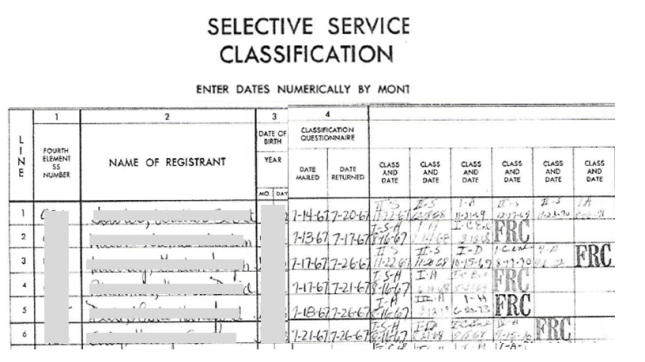
Draft Registration Records for Men Born after 1960
The law never required men to register who were born between March 29, 1957 and December 31, 1959. The National Archives doesn’t hold copies of records for men born after January 1, 1960. To gain access to draft registration for all other years, contact the Selective Service System directly. Click here for all the details.
 Michael L. Strauss contributes the new Military Minutes segment on the Genealogy Gems Podcast. Listen to this segment in the free Genealogy Gems Podcast episode 207.
Michael L. Strauss contributes the new Military Minutes segment on the Genealogy Gems Podcast. Listen to this segment in the free Genealogy Gems Podcast episode 207.
Disclosure: This article contains affiliate links and Genealogy Gems will be compensated if you make a purchase after clicking on these links (at no additional cost to you). Thank you for supporting Genealogy Gems!

